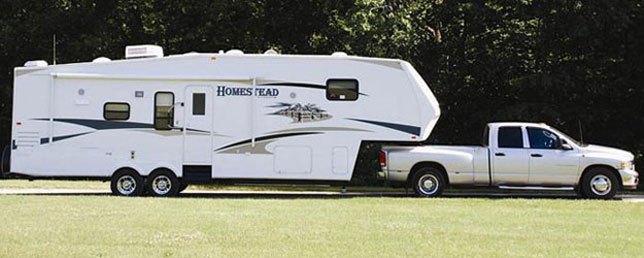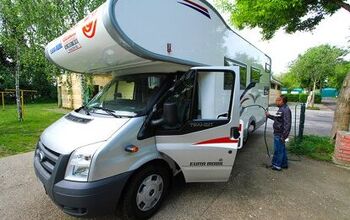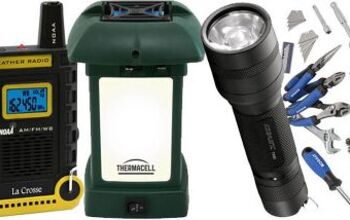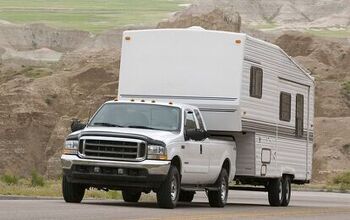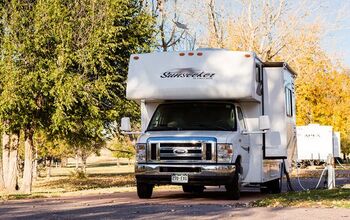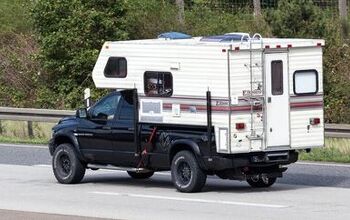The ABCs of Towing
Towing a trailer can be billed as anything from not too hard to very challenging.
If you are already a good driver and naturally inclined to grasping the myriad factors involved in successfully pulling a trailer – be it a small pop-up, a large fifth wheel, a boat, car, or other trailer – that also will affect the quality of your experience.
In any case, you will want to acquaint yourself with all you can in order to make it legal and safe – for you, your family, and anyone you share the road with.
The world of trailer towing is replete with anecdotes of people who failed to account for a critical detail, or loaded something the wrong way and wound up suffering predictable consequences.
So self-educating is the key to safeguarding against potential issues. Likewise, understanding you are the one responsible for staying in control is vital.
If you take it seriously, and do what you need to, then you can be one of the people who find towing to be not such a daunting task, and even enjoyable.
Following are some basics to get you started on your future expertise.
A whole new language?On first blush, it can seem like you need to learn a complete alphabet soup of specialized terms – GVW, GVAR, GVWR, GTW, GCW – and so on …
While it is true you will want to understand them, these terms are less complicated than one might initially imagine.
To make it less intimidating, you can basically divide specifically-defined weight terms into one of two categories:
Firstly, there are terms that describe how heavy something is – either the loaded or unloaded tow vehicle, the trailer, things you carry on the tow vehicle or trailer, and the like.
And secondly, there are terms describing the critical limits of the aforementioned weights – these terms describe maximum safe loading parameters for either the tow vehicle or what it is towing.
Editorial aside: While it might seem as though the invention of the trailer towing lexicon was a virtual field day for mechanical engineers having fun making lay people need to learn dozens of complicated concepts, the idea is actually simple: You need to know how much your vehicle weighs, how heavy the trailer is being towed, and not try to push anything past the safe zone.
So, since it’s really pretty easy in concept, let’s dive right in …
Key terms for weightsNote: Find out how your vehicle’s manufacturer defines curb weight, dry weight and unloaded vehicle weight, etc., as there can be variance to these important definitions.
Curb Weight – This pertains to either the tow vehicle‘s weight or the trailer’s weight. It includes (as applicable) the weight of all fuel, water, propane, and other fluid weights. It does not include people or cargo, just the vehicles otherwise ready to go. Some include the driver or optional equipment in this definition, others do not.
Dry Weight – Refers to the actual weight of a vehicle or trailer without fuel, fluids, cargo, passengers, or optional equipment. Some define it as including optional equipment; some define it as including onboard fluids and RV batteries.
Unloaded Vehicle Weight (UVW) – This is the weight of the manufactured vehicle. It may be an actual weight measured at the factory, or an estimate. It includes full engine and generator fuel tanks, and excludes cargo, water, propane or accessories. Some define it as including equipment optionally installed.
Cargo Weight – Can apply to either the tow vehicle or trailer. It refers to the actual weight of all items added to the Curb Weight of the vehicle or trailer and includes optional equipment, Tongue Weight or King Pin Weight (when referring to the tow vehicle), and what ever else you pile on – that is, it includes the weight of all the food, drink, clothing, electronic equipment, toiletries, dishes, cleaning supplies, BBQ grill, luggage, kids’ toys, bicycles, motorcycles, ATVs, books, magazines, other gear, etc.
Gross Vehicle Weight (GVW) – This is a critical weight to understand. It includes the Curb Weight, Cargo Weight, and total passengers’ (and driver’s) weight. The term can apply to either the tow vehicle, or what it is towing (though trailers get their own special term, see following). The GVW is the whole enchilada – and the only way to know it accurately is to put the vehicle on a public scale.
Gross Combination Weight (GCW) – Equals GVW plus GTW. Only way to know this weight is to drive your tow vehicle and trailer onto a scale.
Gross Axle Weight (GAW) – This is the weight placed on a single axle – of either your tow vehicle (especially the rear axle), or trailer axle(s). This weight also comes into play with tire capacities. If, for example, you have a single axle and four tires on it (dual pickup), you will want to know your tires are rated for the amount. Assuming a well-balanced load, the amount of weight on each tire is calculated by dividing the GAW by the number of tires on the axle.
Weight limitsNote: If you understand the terms above, these should be easy – they are the maximum allowable specs for each.
Payload – This rating is the maximum Cargo Weight plus weight of passengers (including driver) you can carry. It is calculated by subtracting Curb Weight from the GVWR.
Gross Vehicle Weight Rating (GVWR) – Think of this as a “redline” you don’t want to push. It applies to either the tow vehicle or the trailer (sometimes also called Maximum Loaded Trailer Weight). It is the maximum allowable GVW or GTW.
Note: As a word to the wise, you’d be well advised not to push any these, and actually tow below stated limits. A safe rule of thumb is to tow a load at least a good 20 percent less than the tow vehicle’s GVWR.
Gross Combination Weight Rating (GCWR) – Calculated by adding the maximum allowable GVW plus the GTW. It’s the maximum weight for the tow vehicle plus trailer.
Gross Axle Weight Rating (GAWR) – You guessed it. It’s the most weight an axle should be subjected to. If you are talking about the rear or front axle, it could be called RGAWR or FGAWR respectively.
Tongue Weight or King Pin Weight – This is also called Tongue Load, and is the weight of the trailer pushed down on the hitch. It is another critical weight limit you will want to know well. Your tow vehicle can only handle so much, and you should not over-stress it. This also is an indicator of how well your load is balanced front to rear.
A poorly balanced trailer sets you up for handling problems.
For regular (weight carrying) hitches, the trailer’s fore-aft weight distribution should be such that Tongue Weight is 10-15 percent of the GTW (ideally 11-12 percent for RVs). For fifth wheels King Pin Weight should be 15-20 percent of GTW.
Editorial aside: Some recommend weighing tongue weight with a bathroom scale propped on a tree stump, or the like, but if you have a heavy trailer, you’ll need a specialized scale for that much weight, unless your bathroom scale reads over 1,400 pounds (6,349 kilograms).
Is that all?Well, not really, but it’s a start. If you understand those terms, they will be useful in keeping the load within tolerable limits, and making sure you tow safely and securely. There are do-it-yourself calculation formulas for plugging all the data in to determine whether or not your trailer package is feasible.
As mentioned, the calculations are determined by whatever you are using to tow – a truck, SUV, or even an automobile or motorhome – which will have limits set by the manufacturer.
Realize some manufacturers’ claims for certain actual weights may be optimistic, and these can affect your safe towing capability. Actually taking the time to weigh things – like trailer tongue weight, GVW, GTW, and so on are considered smart and the only way to know whether you are pushing your luck or not.
Editorial aside: To put it in human perspective, how would you like it if you were going backpacking, and you knew you felt comfortable with a 25 pound (11 kilogram) pack, but someone made you carry one weighing 65 pounds (29 kilograms)? This is analogous to what some people towing overloaded trailers effectively attempt – whether intentionally or unwittingly. But you can now avoid being one of them, can’t you?
Types of HitchesAside from a light duty bumper hitch, which is not even worth mentioning to RVers, typically you’ll have to choose between a type of square receiver hitch, or a fifth wheel hitch.
Weight Carrying Hitch – This is a standard receiver hitch. It can be any class of receiver hitch not equipped with load equalizing springs as found on a Weight Distributing Hitch.
Weight Distributing (WD) Hitch – This is a Weight Carrying Hitch with additional components that help balance out the load fore and aft. They are typically mandated when you are towing something that weighs 50 percent of your tow vehicle’s weight, or alternately, some truck manufacturers specify their use for trailers weighing over 5,000 pounds (2,268 kilograms).
Weight Distributing Hitches may come in a few designs, but typically use levering springs, which spread some of the weight of the downward force of a trailer tongue (Tongue Weight) – particularly under braking or over bumps – back into the trailer. This has the effect of lifting weight off the tow vehicle’s rear axle, and re-loading the weight onto the front axle (and tires) of the tow vehicle.
Having the front of the tow vehicle properly weighted is vital. If the back wheels were otherwise allowed to be excessively weighted, and the front was un-weighted, it would marginalize steering, braking and directional control. In short, a WD hitch when properly set up helps keep things more planed out and level.
These hitches come equipped with a few possible spring weights, and should be matched for the weight of your trailer. If you get too light a spring weight, the WD hitch will be ineffective, and if you get too strong a spring, it will adversely affect ride quality by being too stiff. A WD hitch naturally reduces sway to some extent.
Anti-Sway Hitch – This is another type of Weight Carrying Hitch equipped with an additional apparatus that helps stop the back-and-forth oscillations known as sway. An anti-sway design may be added to a WD hitch.
Fifth Wheel Hitch – These are mounted to a steel plate secured to a truck bed and a pin fastens the trailer to the hitch. They are more inherently stable, and used for the largest tow-behind RVs that can weigh less than 7,000 pounds (3,175 kilograms) to well over 20,000 pounds (9,070 kilograms).
Gooseneck Hitch – A similar heavy-duty design using a steel plate-mounted ball in a pickup bed like a fifth wheel. These are often seen on livestock trailers.
Note: Fifth wheel and Gooseneck hitches do compromise more than half of a pickup bed, but offer greater maneuverability and security as well handling a potentially higher load.
Hitch ClassesFor regular tow-behind style hitches (Weight Carrying and Weight Distributing with or without anti-sway devices), the Society of Automotive Engineers (SAE) defines their weight capacities according to classes: I, II, III, and IV.
According to Allen Wedertz, a technical advisor for Cequent Group, which manufactures Draw-Tite, Reese and Hidden Hitch brand hitches, a Class V hitch, while stronger than a class IV, is in fact an informal classification, and not a bona fide SAE standard.
Note: Class I or II may use a receiver mount of 1.25 inches square, Class III or IV typically come with 2-inch square receivers. Class V may be 2 inches square, and is commonly seen 2.5 inches square.
Class I – up to 2,000 lbs. (907 kilograms) – The lightest as commonly seen on smaller cars large enough to tow at all.
Caution: These classifications can be misleading if not properly understood. While some people may look at the data plate on their hitch and think they have a specific tow rating, the vehicle it is attached to determines the actual maximum capacity. For example, an SUV could be rated at only 4,000 pounds (1,814 kilograms), but come equipped with a “Class III” hitch. Just because the hitch plate says it can theoretically handle 5,000 pounds (2,268 kilograms), does not mean the SUV it is bolted to can, so in fact, the rating is effectively 4,000 pounds (1,814 kilograms). Always check tow vehicle manufacturer specs to be sure.
Fifth Wheel – These aren’t classed, but are rated for their maximum capacity according to SAE standards. They have been known to come as light as 12,000 pounds (5,442 kilograms) and are more typically engineered to handle from 16,000 pounds (7,256 kilograms) to 30,000 pounds (13,605 kilograms).
Gooseneck – These likewise aren’t classed, but are rated for their maximum capacity according to SAE standards. They’re usually used for agricultural, livestock and equestrian purposes and typically rated at 25,000 pounds (11,338 kilograms) or 30,000 pounds (13,605 kilograms).
Note: While the SAE (and in cases others) have created industry standards, compliance to them by hitch manufacturers is purely voluntary. Wedertz said his company does rigorously test their hitches, but others may not. If you are thinking about cutting costs when buying a new hitch, make sure you research its quality.
Rolling stockTrailers come with Special Trailer (ST) type tires designed to handle loads unique to trailer axles. They have a maximum speed rating of 65 mph (105 kph). If they sit unused for months (or years) on end, they become susceptible to dry rot and naturally lose some of their air pressure.
According to Ed Heard, the owner of Iron Horse motorcycle trailers in Morrison, Tenn., in his travels around the country, he sees trailers being towed with missing or badly damaged fenders – the result of driving too fast on underinflated and/or dry rotted tires.
“But it’s the ones you don’t see that are the scariest,” Heard says. “They’re in the junk yard along with the tow vehicle that was pulling them.”
On the road, if you have dual or tandem tires, you will need to get in the habit of “thumping” them just like the big rig truckers do, or you may not know you have a flat or underinflated tire. The most reliable way to check however, is an accurate pressure gauge.
If your trailer sits for long periods, reducing air pressure and supporting them completely with wood may help some, as will periodically moving the trailer to prevent flat spots. But ST tires still have a limited lifespan. After around three years, ST tires may lose one third of their original strength. Their projected total lifespan is around three to five years. If your ST tires are this old or older, even if they still have tread depth, it would be money well spent to replace them.
Note: Harsh household cleaners and even some automotive tire products can strip protective waxes from ST tires. Check with the tire manufacturer for safe products.
All your trailer tires should be the same size and type. Do not mix bias belted and radial tires. In selecting tires, choose the appropriate size, type, and load range found on the trailer’s certification label or in the owner’s manual.
Whoa!Having brakes able to controllably stop the entire weight of your combined tow vehicle trailer package cannot be emphasized enough.
As it is, marketers are always talking about the high horsepower and high torque capabilities of their engines along with high chassis load carrying limits of their latest trucks, but if you can’t stop in time, you are missing one of the key elements of safe towing.
Fortunately newer heavy-duty trucks do have massive brakes, but you will want to be sure your vehicle has plenty of braking power for your application.
Heavier trailers are equipped with electric brakes, and while these help a lot, it’s recommended your tow vehicle have large and well-serviced disc brakes strong enough to control a trailer without assist on a hill.
Heard says while trailer brakes are valuable, they can be problematic because “manufacturers and dealers continue to equip trailers with electric drum brakes whose performance is fickle at best.”
Although his company manufactures light duty trailers, Heard is in position to see an industry-wide design weakness in which two electrical wires must run from the chassis through the backing plate of each brake drum. It seems no matter what people do to try to protect these wires, Heard says, they remain vulnerable to road debris, salt, and wear and tear from flapping in the breeze.
When either of the wires fails, so do the brakes on that wheel. And since they don’t all fail simultaneously, Heard says that leaves the trailer in question with brakes on one side or one wheel and not on the other side or wheel(s).
Trailer disc brakes – especially in the trailer parts and accessory aftermarket – are on the rise, however, as trailers – aptly named – with suspension and brakes that continue to trail behind automotive technology.
Make sure you’re legalThere are a number of laws you will want to know, especially for interstate or international travel. Each U.S. state has requirements for insurance, trailer speed limit, vehicle specs, maximum weights and heights. Trailer brakes are often required for a loaded weight of over 3,000 pounds (1,361 kilograms).
Further, under federal law, trailers need operable taillights, brake lights, side marker lights, turn signals, and side and rear reflectors. Trailers usually have (and need) backup lights too.
According to Heard, while brake laws do exist at a state level, oddly enough there is otherwise no requirement that manufacturers or dealers equip trailers above that weight threshold with brakes. Although over the road enforcement can be very nearly non-existent, Heard says it is one more thing you can be ticketed for should you have an accident.
However, if you are obviously out of compliance in a particular state, you may cross a border, not speeding at all, and wonder why the highway patrol wants to pull you over.
And to those of you thinking of pushing your weight limits, if your GCVWR (GVWR of both vehicles added together) exceeds 26,001 pounds (11,794 kilograms), you will need a commercial driver’s license (CDL) assuming your trailer also has a GVWR of over 10,000 pounds (4,536 kilograms). Or, if you drive a large single vehicle with a GVWR of over 26,001 pounds (11,794 kilograms), regardless of trailer weight being pulled, you’ll need a CDL. One granted by any state will suffice for interstate travel.
But a CDL is not all you may need. According to Duane DeBruyne, a spokesman for the Federal Motor Carrier Safety Administration (FMCSA), a USDOT number may likewise be important.
This federally issued number – which costs $300 – is needed for compensated interstate transport. This applies even to informal deals with friends who pay you to tow something of theirs from point A to B. For example, if you were a motorcycle enthusiast, and your buddies paid you to transport their motorcycles along with your own to events across state lines and your trailer’s GCVW exceeds 10,001 pounds (regardless of the size of truck), you would need a USDOT number. If you never leave the state, then that’s different – it only becomes a federal matter when a state boundary is crossed.
For more info, you can inquire with the department of motor vehicles in your state, the states you plan to travel through, or http://www.fmcsa.dot.gov/ for federal laws.
In all cases, checking in advance is needed. Making sure you really are insured, and covered fully is also wise. Don’t take anything for granted.
Getting your feet wetWhen you get a new rig together, are sure you are within tolerable weight handling limits, and have loaded everything in a well-balanced way, you can start practicing.
You should become proficient at backing up using your mirrors. When you venture onto public roads, start conservatively, and learn on routes with less traffic, not at first on busy highways that compel you to speed.
Even once you have practiced, everything needs to be done deliberately, and not with steering or braking inputs as sudden as you would be able to give while driving a solo vehicle. You are now operating a heavy hinged vehicle that has a whole new set of rules.
Don’t get caught off guardBeyond issues already mentioned, there are a number of ins and outs to coping with potential problems. For example, if a trailer is induced to sway – and in cases, sway can be severe and affect your control – do not panic or react by trying to steer out of it, or by jamming the brakes. That can make everything much worse. Staying in your lane, gently backing off the accelerator, and lightly applying the trailer brakes are often advised.
Note: Heavier single axle trailers can be more prone to sway. Beyond this, crosswinds or any of several loading and vehicle dynamic variables can cause sway. If you have a real sway problem you can’t readily solve, you should seek an experienced professional to help pinpoint and remedy the issue(s).
Another potentially hair-raising scenario can happen in really strong crosswinds – the danger of losing control or tipping. If you find yourself in a severe windstorm – over 30 mph (48 kph) – you might be better off finding a rest stop or motel to wait it out.
Last wordWhile this article is long, it actually only brushes the high points. It is recommended you continue learning in order to become fully up to speed for your particular application.
And while there is a ton of information out there, you’ll find objective information mixed with a lot of anecdotes and tribal lore. You’ll want to be discriminating therefore, and double check critical facts.
Hopefully this article will get you going in the right direction. Aside from all the cautions we beat the band about, trailer towing is a skill worth learning, and one that will enable you to contemplate and enjoy your next adventure.
